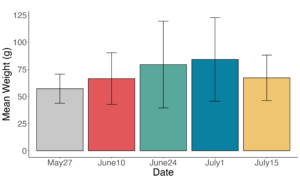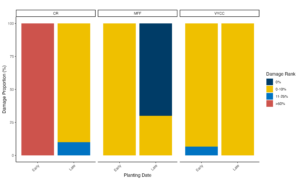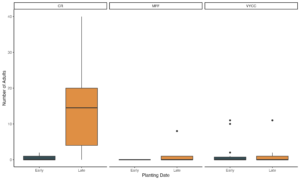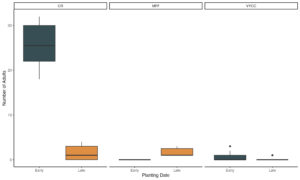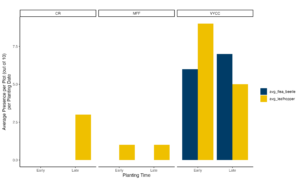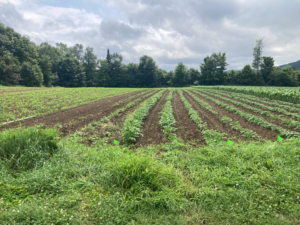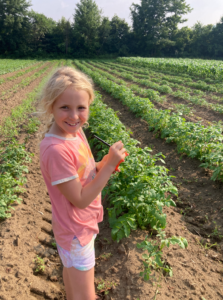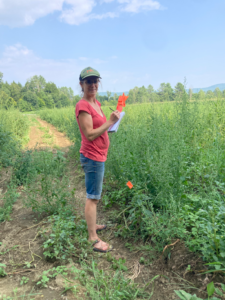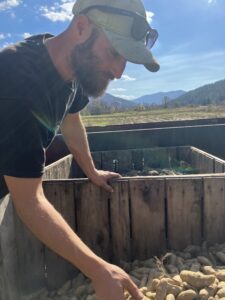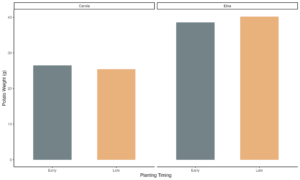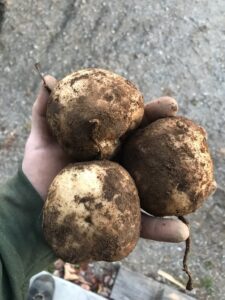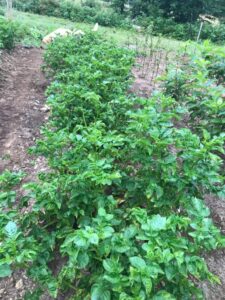Progress report for LNE23-465
Project Information
Fifteen growers adopt Colorado potato beetle management strategies on 20 acres of planted potato, reporting estimated average recovery of losses of $1000/acre.
Problem:
Colorado potato beetle (CPB) represents the most damaging insect pest of potatoes in the northern hemisphere and displays a long history of rapidly evolving pesticide resistance. The beetle currently exhibits insensitivity to over 50 different pesticide chemistries and nearly all insecticide mode-of-action groups. Most farmers dealing with CPB pressure rely heavily upon relatively few pesticide chemistries (e.g. spinosad for organic and neonicotinoids for conventional). In fact, for organic growers, the only rotational option outside of spinosad is the biopesticide Bt. However, over the past several years, the only commercially available formulation of Bt suitable for CPB control has exhibited limited shelf stability. As a result, the primary supplier of the pesticide has halted the production of Bt on several occasions, in an attempt to develop a more stable formulation.
Due to shorter and cooler growing seasons in the northeast, small-to-medium diversified farms (<100 acres) in New England, especially Maine and Vermont, rely substantially on potatoes as a fresh market storage crop (~1700 farms). Provided this investment in potatoes, we will focus our efforts on diversified farms with significant investments in potato. We will also look to engage with a variety of both conventional and organic growers, as we attempt to expand the potential IPM toolbox for all growers struggling with CPB populations.
Proposed Solution:
Through the proposed research and education program, our team will look to identify the best practices currently employed by growers in the New England region with a particular emphasis on the manipulation of planting dates for creating phenological asynchrony (PA) between potatoes and their primary insect pests. Moreover, our team will look to address any knowledge gaps to better support both experienced and novice growers interested in deploying PA tactics or looking to develop their own strategies to disrupt the life cycle of CPB and other relevant pests (e.g. PLH, potato aphid, etc.).
The proposed project represents one of our teams' most exciting, important, low-risk, and well supported endeavors. We are confident that there is a wealth of untapped knowledge within the northeastern farming community related to planting dates and pest management in potato cropping systems. This project affords us the opportunity to uncover (and add to) that knowledge and develop a cohesive and effective educational program to share that knowledge. In addition, because our research trials were conceived to evaluate the agronomic tradeoffs related to different planting dates, any data collected will provide valuable information for understanding the effects of phenology on potato yields, pest management, and marketability.
Research
Research Objective
The aim is to explore the viability of delayed planting for reducing CPB pressure and to evaluate the trade-offs associated with this strategy.
Research Questions:
- How does manipulating planting dates affect CPB pressure in potatoes?
- What are the agronomic tradeoffs (e.g., yield, avg potato size, etc.) with planting date changes?
- What are the pest/disease tradeoffs with planting date changes (e.g., hoppers, blights, etc.)?
All of the treatments within the field trials were directly discussed with a subset of our PAR community farmers. All of the farmers thought it would be best to develop relative dates to each growers typical planting dates rather than choosing specific dates. As a result, for our commercial trials, each farmer will have a delayed planting date that is unique to their farm.
Replicated Experimental Field Trials (Catamount Educational Farm - University of Vermont)
For Year 1 of the project we will (only) be performing a replicated field trial at the Catamount Educational Farm (CEF) located at the Horticultural Research and Education Center of the University of Vermont. This first field trial will allow our team to identify the two best performing treatments to trial on commercial farms. CEF uses low-input practices and has historically avoided pesticide usage for CPB management. As such, none of the treatments will include chemical applications.
The experimental trial will be repeated in Years 2 & 3 of the project (along with the commercial farm trials) to validate our results and to account for yearly variation.
Treatments:
To measure the direct effect of planting dates on CPB pressure we will compare a grower control planting date to both earlier and later planting dates. Dates will be relative dates to the grower control.
Treatments will include:
- Grower control date (GC) - this date will be determined by the grower (i.e. Catamount Farm) based on their typical planting date, with consideration of seasonal variables..
- Two weeks earlier than the grower control (2E)
- Two weeks later than grower control (2L)
- Three weeks later than grower control (3L)
- Four weeks later than grower control (4L)
Experimental Design:
The treatment plots will be distributed in a randomized complete block design with 6 replicates of each treatment. Plots will 10ft X 4ft (based upon typical bed width at CEF). Each plot will be separated by a buffer of cover-crop and staggered so that no two potato plots are adjacent.
Outcome Variables to be measured:
Research Question #1: How does manipulating planting dates affect CPB pressure in potatoes?
All sampling of CPB will be performed on 5 potato stems per plant for all plants in a plot to determine an estimate for CPB pressure. CPB counts will be recorded weekly starting the week after the first CPB adults are identified in any of the potato plots.
- Number of egg masses
- Number of young larvae (1st and 2nd instar)
- Number of old larvae (3rd and 4th instar)
- Number of adults
Research Question #2: What are the agronomic tradeoffs (e.g., yield, avg potato size) with planting date changes?
- Total potato yield per plot
- Average potato size per plot (sizes A, B, C)
Research Question #3: What are the pest/disease tradeoffs with planting date changes (e.g., hoppers, blights, etc.)?
Disease incidence will be measured as the number of diseased plants per plot. Potato leafhopper incidence will be measured as the number of "hopper-burned" leaves on 5 stems per plant for all plants in a plot. Disease and leafhopper scouting will occur during the weekly CPB counts.
- Incidence of disease
- Number of "hopper-burned" leaves
Data Analysis:
For statistical analysis, we will use a linear mixed model with treatments as a fixed effect and blocks as a random effect to compare means among treatments. If the data is not normally distributed we will use a generalized linear mixed model. All statistical modeling will be performed using RStudio Team (2020) to determine significance among treatments.
Commercial Farm Trials Years 2 and 3 (Farms in VT and ME)
The two best performing treatments will be selected from the replicated experimental field trial to be applied on 10 farms in Vermont and Maine ( we currently have commitments from more than 10 farms to participate). We will divide the farms into two groups, one for each treatment (ex. 5 farms treatment #1 + 5 farms treatment #2). Treatment groups will be determined in consultation with all of the participating farmers. Each farm will provide feedback on which treatment would work best on their farm provided their crop plan.
Experimental Design:
Each farm will apply a single treatment to (at least) one full bed that will be divided/separated from the main potato planting by (at least) a buffer of cover crop or other non-solanaceous crop. Selected non-treatment bed(s) will act as the on-farm control.
Each farm will be considered a paired replicate (control + treatment).
Outcome Variables to be measured:
For the commercial on-farm trials we will be collecting data that reflects information relevant to commercial production (e.g rating scales for CPB impact, potato size, etc.)
Research Question #1: How does manipulating planting dates affect CPB pressure in potatoes?
Six 20ft plots will be marked with flagging at the beginning of the season in each of the treatment and control sections and will be designated as the data collection plots. Data will be collected in each of the these plots at two time points during the season, mid-season and pre-harvest.
- For each plot = Severity of CPB damage ranking (0-4)
- 0 = 0%
- 1 = 10%
- 2 = 25%
- 3 = 50%
- 4 = 75% or more
Research Question #2: What are the agronomic tradeoffs (e.g., yield, avg potato size) with planting date changes?
At harvest, 200 potatoes will be harvested from the treatment and control beds and collect the following data:
- Total potato yield
- Average potato size (sizes A, B, C)
Research Question #3: What are the pest/disease tradeoffs with planting date changes (e.g., hoppers, blights, etc.)?
Disease incidence will be measured as the number of diseased plants per plot and severity of disease using a rating scale. Potato leafhopper incidence will be measured using a rating scale.
- Incidence of disease
- Severity of disease
- 0 = 0%
- 1 = 10%
- 2 = 25%
- 3 = 50%
- 4 = 75% or more
- Severity of "hopper burn" ranking (0-4)
- 0 = 0%
- 1 = 10%
- 2 = 25%
- 3 = 50%
- 4 = 75% or more
-
Data Analysis:
For statistical analysis, we will again use a linear mixed model but farms will be added as a fixed effect to the previous model to compare means among treatments. If the data is not normally distributed we will use a generalized linear mixed model to account for the non-normal distribution. All statistical modeling will be performed using RStudio Team (2020) to determine significance among treatments.
Field Season 2024
Research Trial Results
Our research trial was established at the University of Vermont Horticultural Research and Education Center. We prepared a five-bed layout measuring 116 feet in length. Each plot contained 20 potato plants, spaced 1 foot apart within rows and 1.5 feet between rows.
We planted potato seeds weekly over five weeks, starting on May 27, 2024. To ensure randomness, we assigned unique identifiers to each plot based on its bed and planting sequence. The planting schedule was as follows: Week 1 (May 27), Week 2 (June 10), Week 3 (June 24), Week 4 (July 1), and Week 5 (July 15).
We measured crop yield early in September. The delayed planting on June 24th and July 1st resulted in the highest yields.
Figure 1. Delayed planting on June 24th and July 1st resulted in the highest yields based on trial results.
On-Farm Trial Results: Vermont and Maine
We conducted late planting trials on farms in Vermont and Maine to compare delayed potato planting with each farm’s standard practices. Initially, six farms in Vermont committed to the study, but due to flooding and other unforeseen challenges, only three farms were able to complete the trial. Similarly, in Maine, three farms participated, but one farm lost its crop entirely due to tight scheduling constraints, leaving two farms that successfully completed the trial.
The participating farms in Vermont included Bear Roots (Williamstown), Crossroads (East Thetford), Jericho Settlers (Jericho), Mighty Food Farm (Shaftsbury), VYCC (Underhill), and Otter Point (West Haven). In Maine, the participating farms were Bumpa Farm (South Paris), Nettie Fox Farm (Newburgh), and Murphy Family Farm (Freedom).
Vermont On-Farm Trials
In Vermont, we analyzed plant damage (defoliation) and pest pressure across early and late plantings. Our results showed that late plantings had significantly lower damage scores (p < 0.001), suggesting that later planting dates may reduce defoliation. CPB adult counts also varied between planting timings, with Wilcoxon rank-sum tests confirming significant differences (p < 0.001 for two farms, p = 0.025 for another). However, when aggregating across all farms, a Kruskal-Wallis test did not find an overall significant difference in CPB adult numbers (p = 0.093).
For larvae counts, early plantings had significantly fewer larvae than late plantings at two farms (p < 0.001, p = 0.002), while the third farm showed no significant difference (p = 0.459). The Kruskal-Wallis test confirmed an overall significant difference in larvae numbers between early and late plantings (p < 0.001).
We also assessed the impact of farm location and planting timing on the presence of leafhoppers and flea beetles. ANOVA results indicated that farm location significantly influenced pest presence, with leafhopper occurrence varying by farm (p = 0.0131) and flea beetle presence showing a highly significant difference (p < 0.0001). However, planting timing had no significant effect on either pest, as there was no statistical difference in leafhopper (p = 0.8021) or flea beetle (p = 0.758) presence between early and late plantings. These findings suggest that leafhopper and flea beetle pressure is more strongly influenced by farm-specific conditions rather than planting date.
Figure 2. Results from Vermont on-farm trials comparing early and late planting dates. (Left) Proportion of plant damage (defoliation). (Center) Average number of adult Colorado Potato Beetles (CPB) per plant. (Right) Average number of CPB larvae per plant.
Figure 3. Leafhopper and flea beetle presence in Vermont on-farm trials.
Figure 4. Vermont on-farm trial. (Left) Field overview. (Center) Our team collaborating with farmers and scouting. (Right) Sorting potatoes.
Maine On-Farm Trials
At Bumpa Farm, we planted Elba and Carola potatoes in both early (May 24) and late (June 12) plantings. Leafhoppers caused significant damage to the early-planted Carola, while Elba remained largely unaffected. By October, the first planting had deteriorated, while the second planting remained green. Yield analysis showed no significant difference between early and late plantings, with average weights of 32.53g and 32.80g, respectively (p = 0.98). Variety had a greater influence on weight than planting timing, though this effect was not statistically significant.
At Nettie Fox Farm, we established a main planting (May 7-8) and a later test plot (May 29) to assess the impact of delayed planting on pest pressure and yield. By mid-June, CPB larvae were more abundant in the main planting, while the test plot had more emergent adults. Despite multiple spray applications (Mycotrol, neem, and other treatments), pest pressure persisted, leading to significant defoliation in the main planting by July, while the test plot remained healthier.
Leafhoppers arrived in mid-June, further weakening the plants. By August, pest pressure and weed competition resulted in major losses, particularly in the later planting, which had to be mowed down due to poor regrowth. Yield varied by variety, with Natascha and Chieftain performing well, while Caribe underperformed.
At Murphy Family Farm, the second planting of Natascha potatoes was completely lost to CPB, while the first planting yielded a modest 12 pounds per 10 feet. A third planting at a separate site with lower CPB pressure was not harvested at the time of analysis. CPB management was especially difficult this season, as labor limitations prevented intensive manual beetle removal.
To address this, the farm tested a battery-powered Milwaukee backpack vacuum for CPB removal, which proved effective for small beetle populations. Future trials will explore early-season implementation of this method to improve CPB control.
Figure 5. Potato yield at Bumpa Farm comparing early and late planting dates for two different potato varieties.
Figure 6. Maine on-farm trial. (Left) Crop yield. (Center) Leaf hopper damage on Carola variety. (Right) No leaf hopper damage on Elba variety.
Farmer Feedback on Planting Strategies
Participating farmers provided valuable insights on the impact of planting timing on yield, pest pressure, and crop management. Their experiences reinforce key findings from this study and highlight the practical implications for improving potato production.
Mighty Food Farm observed higher yields with later plantings, noting that while early-planted varieties tended to produce smaller tubers, later-planted russets averaged approximately 3 pounds per plant. Their experience suggests that later planting can support better tuber development while maintaining manageable pest pressure.
Crossroads Farm reported significantly lower pest pressure in later plantings, particularly for Colorado Potato Beetles (CPB) and Potato Leafhoppers (PLH). They noted that their second planting had minimal disease or bug pressure and that pests were much easier to control in July and early August. As a result, they plan to continue using this planting strategy and suggest that organic growers could benefit from row covers to further reduce pest incidence.
At Bumpa Farm, differences in pest pressure were observed between varieties, with leafhoppers severely impacting the early Carola planting but not Elba. The later-planted potatoes had higher CPB pressure, but notably, hopperburn was much lower in the second planting. The farmer also noted that later plantings required less hilling, reducing labor input.
At Nettie Fox Farm, CPB were more concentrated in the main planting, whereas the test plot, planted three weeks later, had fewer larvae and a healthier canopy. However, the early arrival of leafhoppers severely weakened both plantings, leading to rapid plant decline. The farmer noted that delayed planting initially seemed beneficial but ultimately did not compensate for high leafhopper pressure, raising questions about pest migration patterns in storm systems.
Murphy Family Farm faced significant CPB losses in their second planting, with one field being completely destroyed by beetles. The farmer, unable to conduct manual beetle removal as extensively as in previous years, experimented with a battery-powered vacuum for CPB control, which showed promise for managing small beetle populations. They anticipate testing this method more thoroughly next season.
These testimonials align with the quantitative findings of this study, suggesting that later plantings may offer advantages in both yield and pest management. However, farm-specific factors, such as varietal susceptibility and leafhopper migration, can heavily influence success. Farmer-reported experiences underscore the need for continued research into optimal planting dates and integrated pest management strategies.
Outreach
Outreach efforts included presentations at regional and national conferences:
Nouri-Aiin, M. (2024, December 17). On-farm innovations for Colorado potato beetle management beyond Entrust. New England Vegetable & Fruit Conference, Manchester, NH, USA. ~150 attendees.
Nouri-Aiin, M., Lewins, S., & Izzo, V. (2024, November 13). Eco-friendly pest management strategies for late-season root crops: Integrating entomopathogenic fungi and RNA interference in Northeastern diversified farms. Entomological Society of America Annual Meeting, Phoenix, AZ, USA. ~60 participants.
Eller, K., Izzo, V., & Nouri-Aiin, M. (2024, November 11). Wireworm populations in Vermont. Entomological Society of America Annual Meeting, Phoenix, AZ, USA.
Izzo, V.. (2024, September 7). What’s the buzz on pest management with Vic Izzo. Arlington Garden Club Arlington, VT. ~40 participants.
Izzo, V.. (2024, April 3). Colorado potato beetle information session. VVBGA webinar. 24 participants (4 Extension + 20 farmers/gardeners)
Hosted Vermont Entomology Participatory Action and Research (VE-PAR) meeting with 9 farmers to discuss results and receive feedback (2024, March 10).
Field Season 2023
Objective:
The research aimed to explore the viability of delayed planting for reducing Colorado potato beetle (CPB) pressure and to evaluate the trade-offs associated with this strategy.
Research Questions:
- How does manipulating planting dates affect CPB pressure in potatoes?
- What are the agronomic tradeoffs (e.g., yield, avg potato size, etc.) with planting date changes?
- What are the pest/disease tradeoffs with planting date changes (e.g., hoppers, blights, etc.)?
Experimental Design:
At the Horticultural Research and Education Center of the University of Vermont (HREC), a replicated field trial was conducted as the first phase of the project. The goal of this trial was to identify the two best performing treatments to trial on commercial farms. HREC, known for its low-input practices and historical avoidance of pesticide usage for CPB management, provided an ideal setting for this initial investigation. Consequently, none of the treatments included chemical applications. The treatments included:
- May 31st , Grower control date for HREC based on their typical planting date
- May 16th , Two weeks earlier than HREC control
- June 14th, Two weeks later than HREC control
- June 21st, Three weeks later than HREC control
- July 1st, Four weeks later than HREC control
The treatment plots were distributed in a randomized complete block design with 5 replicates of each treatment. Each plot measured 10ft X 4ft, based on the typical bed width at CEF. To minimize potential interference, each plot was separated by a 20ft x 4ft buffer of buckwheat and staggered so that no two potato plots were adjacent.

Results:
It was observed that due to the high precipitation, leading to flood fields and the allelopathic potential of the buffer crop species (buckwheat), the germination rate in potatoes that were planted two weeks or later was severely reduced to <30% with some plots completely failing to germinate. As a result, our team was unable to collect useful data for analysis.
Conclusion:
The initial phase of the research project at the UVM Horticultural Research and Education Center provided valuable insights into the challenges associated with delayed planting as a strategy to reduce Colorado potato beetle pressure. First, the use of buckwheat as a buffer crop between plots is likely a poor choice and will therefore be replaced with bare ground or some slow-growing grass cover crop. In addition, we will begin our on-farm trials this upcoming on ~10 commercial farms in ME and VT.
Education
ENGAGEMENT :
Leader(s): Becky Maden and Caleb Goossen
Recruitment
Initial farmer recruitment for educational events, knowledge transfer and workshops began with direct recruitment from our current network of partner growers over the past two growing seasons. As part of an on-going participatory action research (PAR) project, our research team actively and consistently engages with over 30 growers in the VT, ME, and NY. These partner growers are in contact with our team in different capacities throughout the year. In addition, as part of our current pest and monitoring program we are in weekly communication with growers through our weekly pest newsletter. Further recruitment will be facilitated through our other extension networks in NH, MA, and PA. We have already received commitments for our educational programs from 20 growers via the aforementioned channels. We will also extend our recruitment efforts to include regional newsletters and listserves (e.g. UMASS VegNotes, etc.). Participation in the educational program will occur on a rolling basis throughout the project.
LEARNING:
Leader(s): Scott Lewins, Vic Izzo and Becky Maden
Educational Curriculum
Our educational curriculum will focus upon adaptable information to aid farmers in applying sustainable IPM tactics both new and old for the management of Colorado potato beetle (CPB) and other potato pests, with a particular emphasis on potato cropping systems. Learning outcomes for this curriculum will be divided into two categories: knowledge building and skills development.
Knowledge Building
Growers participating in our educational program will receive detailed and practical knowledge on a variety of relevant topics. These topics shall include:
-
- the ecology and biology of CPB
- cultural control tactics for CPB management;
- biology and mode of actions for biologically based IPM tactics including: spinosad based applications, entomopathogenic fungi and entomopathogenic nematodes;
- best practices for implementing delayed/early planting tactics, including results from our research trials.
Skills Development
Growers will be trained in the proper deployment of various low-impact and ecologically based IPM tactics for CPB management. These training will pay particular attention to cultural control tactics including varietal selection, rotational strategies and the manipulation of planting dates (as tested in our field trials). Farm demonstrations and field days at our field sites will provide growers the opportunity to directly observe our field trials and learn via farmer-to-farmer trainings led by farmers hosting field trials.
Instructional methods
Yearly research site field days, individual and remote consultations, and extension workshops (beginning in year 2) will directly support our educational curriculum. Farmer-to-farmer communication will also be facilitated through farm demonstrations, PAR meetings and postings to northeastern Veg and Fruit Listserves. Results from our trials will also be posted on the www.uvm.edu/agroecology. In addition, we will present the results of this project at regional and national conferences including: NOFA conferences, Entomological Society meetings, and regional Vegetable and Fruit Grower meetings. We will also develop a new fact sheet to include the most up to date information on the current control strategies and any relevant results from our trials.
EVALUATION:
Leader(s): Becky Maden and Scott Lewins
Pre-project informational surveys with a short project description and performance target will be distributed to farmers throughout the first year of the project. To best acquire a true representative sample of grower knowledge, surveys will be disseminated multiple times during the initial field season. Survey responses will provide data on: the current demographics of interested farmers, the extent of CPB/PLH issues, the current tactics being employed for these pests, and the potential for the adoption of alternative planting schedules.
Surveys will be distributed electronically via local listserves and appropriate extension channels. Our advisory board members include extension and farm community partners. We will leverage their networks to best achieve our target audience. Participants interested in learning more about the tactics discussed during any of our field days or other communications will receive direct consultations and educational materials. Information gathered during field days and consultations will provide formative assessments during the project.
Post-project verification surveys (i.e. summative evaluation) will provide data to assess built knowledge and the extent of adoption of any new tactics shared during our program. Verification surveys will be distributed during the winter following the completion of our last field trial. Surveys will be directed towards all educational participants.
Summative evaluations will also be conducted using a grower-oriented approach and look to answer the following:
- Content quality. Was the content useful and of high quality? Did the content serve growers' needs?
- Effective delivery. Was the content effectively communicated and at the appropriate level?
- Project impact and outcomes. Did the educational programing change grower behavior?
Milestones
ENGAGEMENT
Milestone 1
- Number of participants: 150 farmers
- What farmers learn or do: Will be contacted through northeastern grower listserves (e.g. MOFGA, VVBGA, etc.), direct solicitations, and summer conferences to join the educational program.
- Proposed completion date: Completed June 30 2023. The project and educational programing was announced and initiated through VVBGA and MOFGA listservs.
- Status Update: The project and educational programming were successfully announced and initiated through the listservs and local/regional meetings targeting >300 farmers.
Milestone 2
- Number of participants: 40 farmers
- What farmers learn or do: Will be enrolled in the educational program and complete a pre-project survey to determine the current level of CPB knowledge, most commonly used practices, and familiarity with delayed planting tactics.
- Proposed completion date: July 31 2024
-
Status Update: Surveys distributed to 85 growers through email and in 2024 Farmer to Farmer Conference in Maine. A total of 22 farmers completed the survey.
Milestone 3
- Number of participants: 18 farmers (9 from Maine & 9 from VT)
- What farmers learn or do: Will commit to join the Participatory Action Research portion of the project and agree to meet for a participatory meeting once per year. One meeting in VT and another in Maine
- Proposed completion date: January 30, 2024; January 30, 2025; January 30, 2026
- Status Update: 9 farmers in Vermont joined the PAR meeting in February 2024. Second Vermont PAR meeting is scheduled for March 2025 and Meeting in Maine is scheduled for early fall 2025.
Milestone 4
- Number of participants: 12 farmers (4 from Maine & 8 from VT)
- What farmers learn or do: Will commit and host simplified field trials on their farms
- Proposed completion date: Oct 20, 2024; Oct 20, 2025
- Status Update: 6 farmers committed to participate in the on-farm trails, 3 farms had to setback because of the flood in Vermont, and 3 farmers in Maine farms participated in our on-farm trails, completed in October 2024.
--------------------------------------------------------------------------------------------------------------------------------------------------------------------------------
LEARNING
Milestone 5
- Number of participants: 80 farmers (~20 per workshop)
- What farmers learn or do: Will attend workshops and/or field days on the biology & ecology of potato insect pests, current non-chemical control options (including alternative planting) and updates on our research trials. Workshops will be held in both VT and Maine, (on farms that are hosting trials if possible).
- Proposed completion date: September 30 2024; September 30, 2025
- Status Update:223 farmers participated in our workshops in different regional and local meetings by December 2024.
Milestone 6
- Number of participants: 150 farmers;
- What farmers learn or do: Will receive yearly research briefs on current best practices for CPB management and proper application of delayed potato planting for better outcomes and updates on our research trials. Briefs will be sent via grower listserves in VT, MA, and ME
- Proposed completion date: February 28, 2024; February 28, 2025; February 28, 2026
- Status Update: Unfortunately our research trials were not successful due some unforeseen germination issues. However, our research brief for all of our research projects (including CPB) will be distributed by February 28 2024. We are set to distribute our research brief by the end of February 2025.
Milestone 7
- Number of participants: 100 farmers
- What farmers learn or do: Will attend lectures on the biology & ecology of potato insect pests, current non-chemical control options (including alternative planting) and updates on our research trials presented by our team at northeastern grower conferences
- Proposed completion date: February 28 2024; February 26 2026
- Status Update: Lectures were successfully presented, in the New England Vegetable & Fruit Conference (December 2024) (~150 attendees), Entomological Society of America (November 2024) (~ 60 attendees), and VVBGA Webinar (April 2024) (24 attendees).
Milestone 8
- Number of participants: 15 farmers
- What farmers learn or do: Will receive remote or on-farm consultations to improve upon their CPB and other potato pest management strategies and to provide support for the implementation of delayed planting.
- Proposed completion date: February 28, 2024; February 28, 2025; February 28, 2026
- Status Update: Due to poor germination in the research trial, consultations were limited for the milestone set for 2024. Consultations were conducted with 8 farmers in early 2024 in Vermont and 3 in Maine.
--------------------------------------------------------------------------------------------------------------------------------------------------------------------------------
EVALUATION
Milestone 9
- Number of participants: 18 farmers
- What farmers learn or do: Will attend PAR meetings which will provide a formative assessment of the R&E program. During these meetings we will discuss the strengths and weakness of the program and develop strategies to improve upon the content delivery and address any concerns for the project. This farmer-to-farmer session will also provide farmers the opportunity to weigh in on our field trials and discuss ways to improve or add to the scope of the trials for the upcoming season.
- Proposed completion date: February 28 2024; February 28 2025.
- Status Update: The first PAR meeting was held in March 2024, with 9 farmers attending. A second meeting is scheduled for March 12, 2025.
Milestone 10
- Number of participants: 40 farmers
- What farmers learn or do: Will receive and complete a verification survey as a summative assessment to evaluate the quality of the content provided during the educational program, the efficacy of the content delivery and the overall impact and outcomes of the R&E program.
- Proposed completion date: March 30 2026
- Status Update: Surveys will be developed and distributed in late 2025.
Milestone 11
- Number of participants: 150 farmers
- What farmers learn or do: Will receive an electronic factsheet providing the most up to date information on the current control strategies and any relevant results from our trials.
- Proposed completion date: March 30 2026
- • Status Update: Factsheet development is scheduled for early 2026 based on final research results.
Milestone 12
- Number of participants: 100 farmers
- What farmers learn or do: will acquire and apply knowledge of Colorado potato beetle biology and ecology with particular attention to IPM strategies for reducing dependency on chemical controls. Application of this knowledge will occur on up to 100 acres of potato cropland protecting $300,000/year worth of potatoes. Of these 100 growers, fifteen will report their estimated average recovery of losses
- Proposed completion date: March 30 2026
- Status Update: Some farmers have started implementing changes based on research, but full assessment will take place closer to 2026.
Performance Target Outcomes
Target #1
15
Growers adopt Colorado potato beetle management strategies
20 acres of planted potato
Growers report an estimated average recovery of losses of $1000/acre
